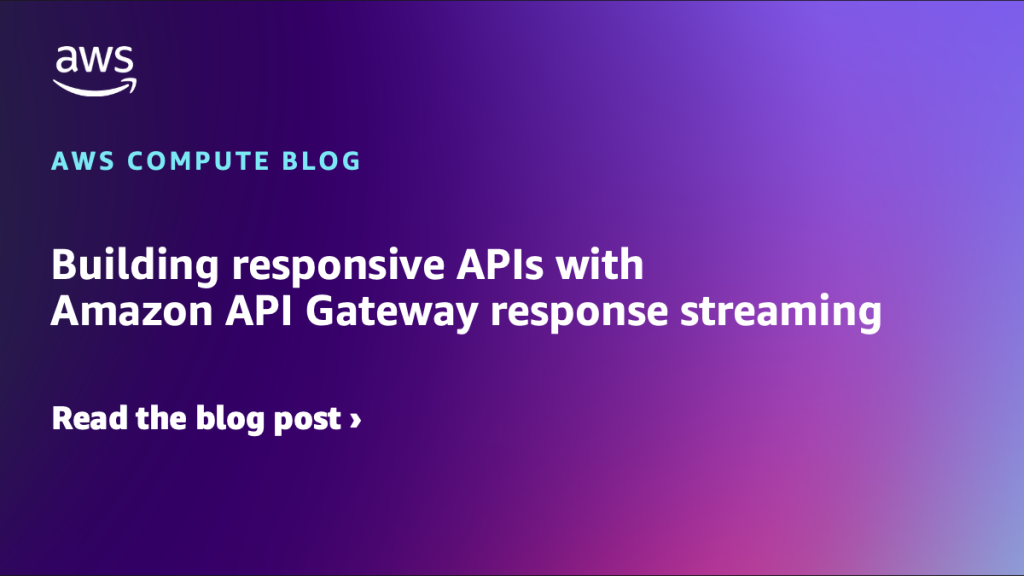AWS Compute Blog
Category: Amazon API Gateway
Building responsive APIs with Amazon API Gateway response streaming
Today, AWS announced support for response streaming in Amazon API Gateway to significantly improve the responsiveness of your REST APIs by progressively streaming response payloads back to the client. With this new capability, you can use streamed responses to enhance user experience when building LLM-driven applications (such as AI agents and chatbots), improve time-to-first-byte (TTFB) performance for web and mobile applications, stream large files, and perform long-running operations while reporting incremental progress using protocols such as server-sent events (SSE).
Introducing an enhanced in-console editing experience for AWS Lambda
AWS Lambda is introducing a new code editing experience in the AWS console based on the popular Code-OSS, Visual Studio Code Open Source code editor. This brings the familiar Visual Studio Code interface and many of the features directly into the Lambda console, allowing developers to use their preferred coding environment and tools in the cloud. […]
Best practices for working with the Apache Velocity Template Language in Amazon API Gateway
This post is written by Ben Freiberg, Senior Solutions Architect, and Markus Ziller, Senior Solutions Architect. One of the most common serverless patterns are APIs built with Amazon API Gateway and AWS Lambda. This approach is supported by many different frameworks across many languages. However, direct integration with AWS can enable customers to increase the […]
Propagating valid mTLS client certificate identity to downstream services using Amazon API Gateway
This blog written by Omkar Deshmane, Senior SA and Anton Aleksandrov, Principal SA, Serverless. This blog shows how to use Amazon API Gateway with a custom authorizer to process incoming requests, validate the mTLS client certificate, extract the client certificate subject, and propagate it to the downstream application in a base64 encoded HTTP header. This […]
Building resilient private APIs using Amazon API Gateway
This post written by Giedrius Praspaliauskas, Senior Solutions Architect, Serverless. Modern architectures meet recovery objectives (recovery time objective, RTO, and recovery point objective, RPO) by being resilient to routine and unexpected infrastructure disruptions. Depending on the recovery objectives and regulatory requirements, developers must choose the disaster recovery strategy. For more on disaster recovery strategies, see […]
Integrating Amazon API Gateway private endpoints with on-premises networks
This post was written by Ahmed ElHaw, Sr. Solutions Architect Using AWS Direct Connect or AWS Site-to-Site VPN, customers can establish a private virtual interface from their on-premises network directly to their Amazon Virtual Private Cloud (VPC). Hybrid networking enables customers to benefit from the scalability, elasticity, and ease of use of AWS services while […]
Getting started with serverless for developers: Part 3 – The front door
This blog post is part 3 of Getting started with serverless for developers, helping developers to start building serverless applications from their IDE. In the previous post, I introduce AWS Lambda and show how functions are designed to run business logic for serverless applications. In this blog post, you see how to access that business […]
Performing canary deployments for service integrations with Amazon API Gateway
This post authored by Dhiraj Thakur and Sameer Goel, Solutions Architects at AWS. When building serverless web applications, it is common to use AWS Lambda functions as the compute layer for business logic. To manage canary releases, it’s best practice to use Lambda deployment preferences. However, if you use Amazon API Gateway service integrations instead […]
Troubleshooting Amazon API Gateway with enhanced observability variables
Amazon API Gateway is often used for managing access to serverless applications. Additionally, it can help developers reduce code and increase security with features like AWS WAF integration and authorizers at the API level. Because more is handled by API Gateway, developers tell us they would like to see more data points on the individual […]
Building a serverless document scanner using Amazon Textract and AWS Amplify
This guide demonstrates creating and deploying a production ready document scanning application. It allows users to manage projects, upload images, and generate a PDF from detected text. The sample can be used as a template for building expense tracking applications, handling forms and legal documents, or for digitizing books and notes. The frontend application is […]









